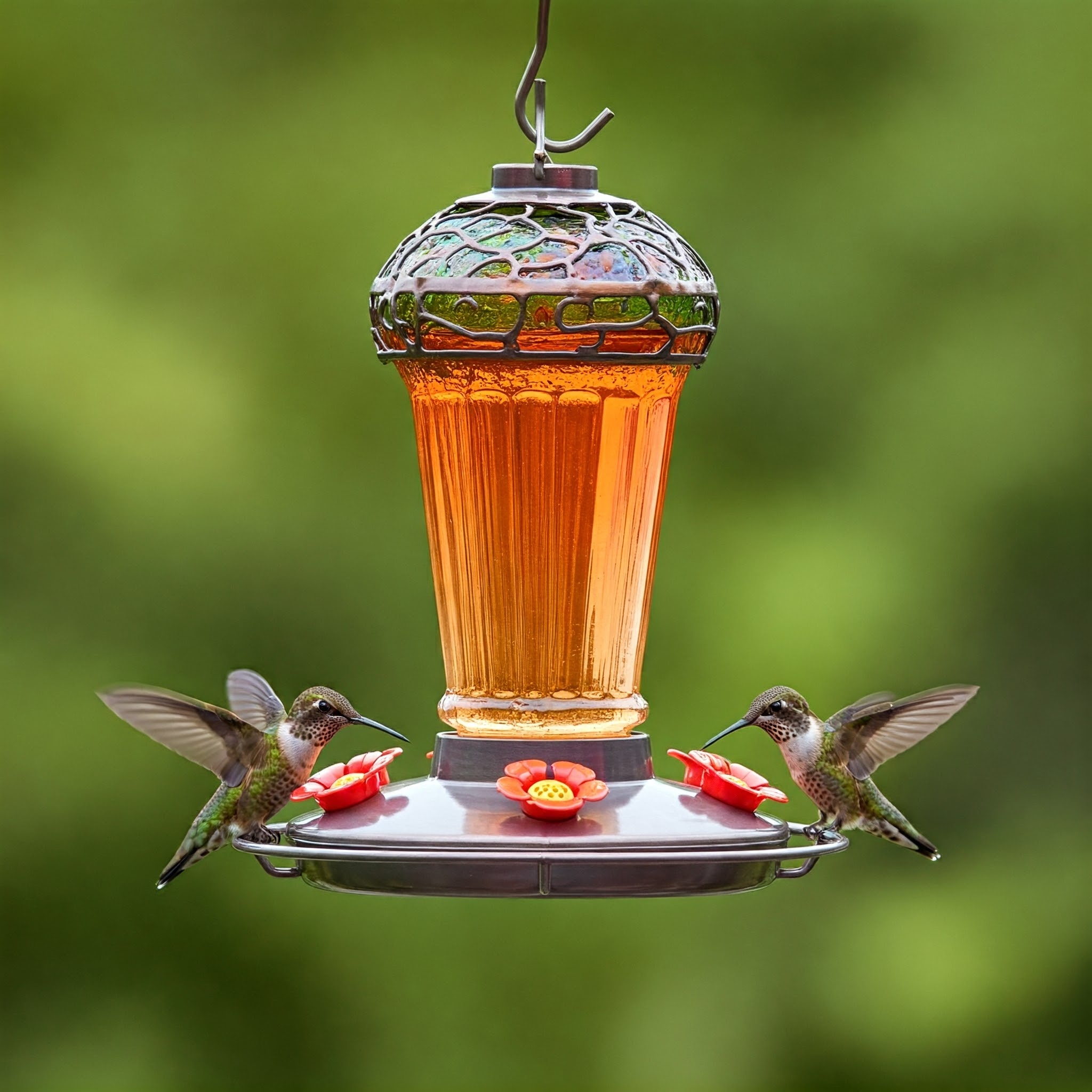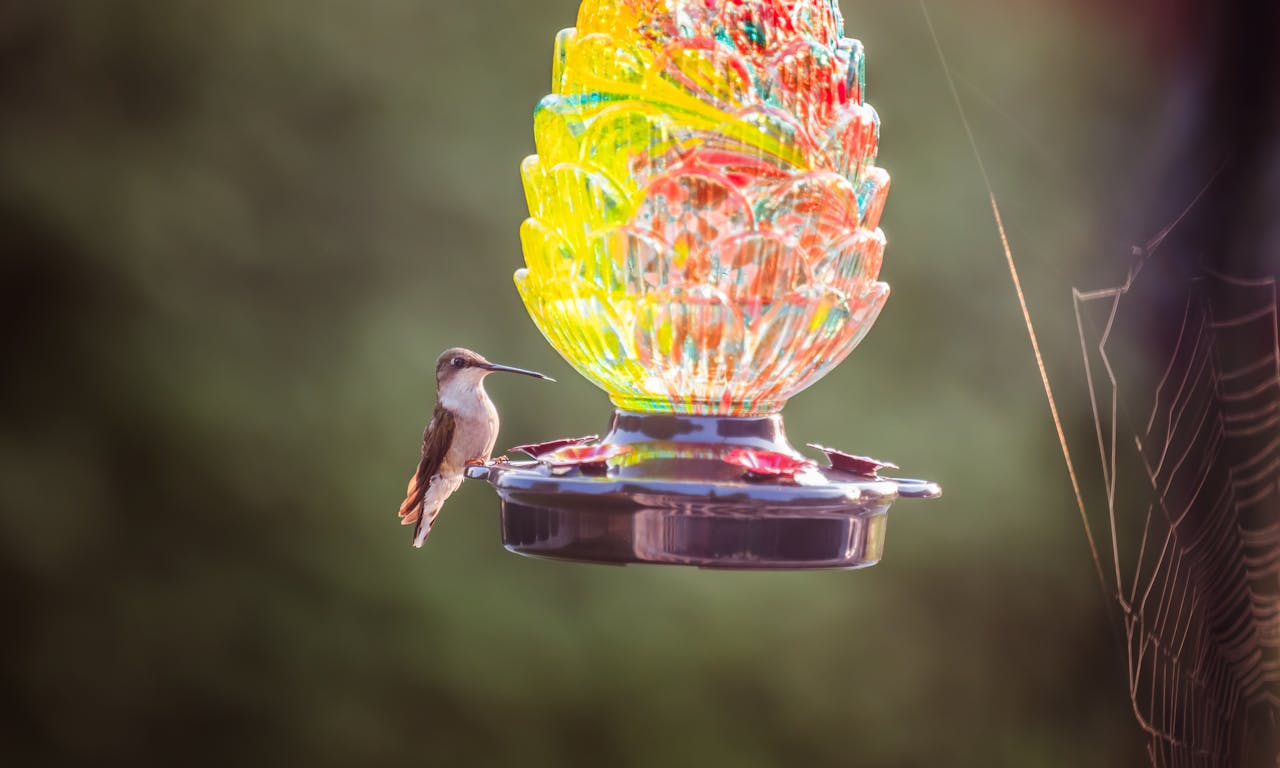- Welcome to avian artistry
- birdwatching is therapeutic
- what is a hummingbird?
- a glimpse of hummingbirds in their enchanting splendor
- what is a hummingbird feeder?
- What is a Decorative Hummingbird Feeder?
- Why Should Novices opt for Decorative Hummingbird Feeders?
- Captivating Features to Look for in Decorative Hummingbird Feeders
- The Value of Decorative Hummingbird Feeders
- Smart Investing Tips for the Best Decorative Hummingbird Feeder
- What are some Types of Decorative Hummingbird Feeders?
- Conclusion
What is a decorative hummingbird feeder? A masterpiece that blends beauty and function, inviting hummingbirds while adding elegance and charm to your outdoor oasis. Explore more!
This article delves into the question of what is a decorative hummingbird feeder. We will also explore the following questions:
(1) What is a hummingbird?
(2) What is a hummingbird feeder?
(3) Why opt for a decorative hummingbird feeder?
(4) Unique features to look for in decorative hummingbird feeders; and
(5) What are some types of decorative hummingbird feeders?
birdwatching is therapeutic
Whether its feeding, watching or photography, interactions with wild birds, and enchanting magical birds like hummingbirds, benefits both birds and humans.
According to joint research by academics from the University of Exeter, the British Trust for Ornithology and the University of Queensland, people living in an environment with more birds, shrubs and trees are less likely to suffer from stress, anxiety and mood disorders such as depression.
Immersing in nature, like feeding, watching and caring for hummingbirds, and in a beautiful garden can help improve mental and emotional well-being. Backyard birding is therapeutic for healing and restoration. It slows you down, brings you to the present and directs your senses towards the natural world.
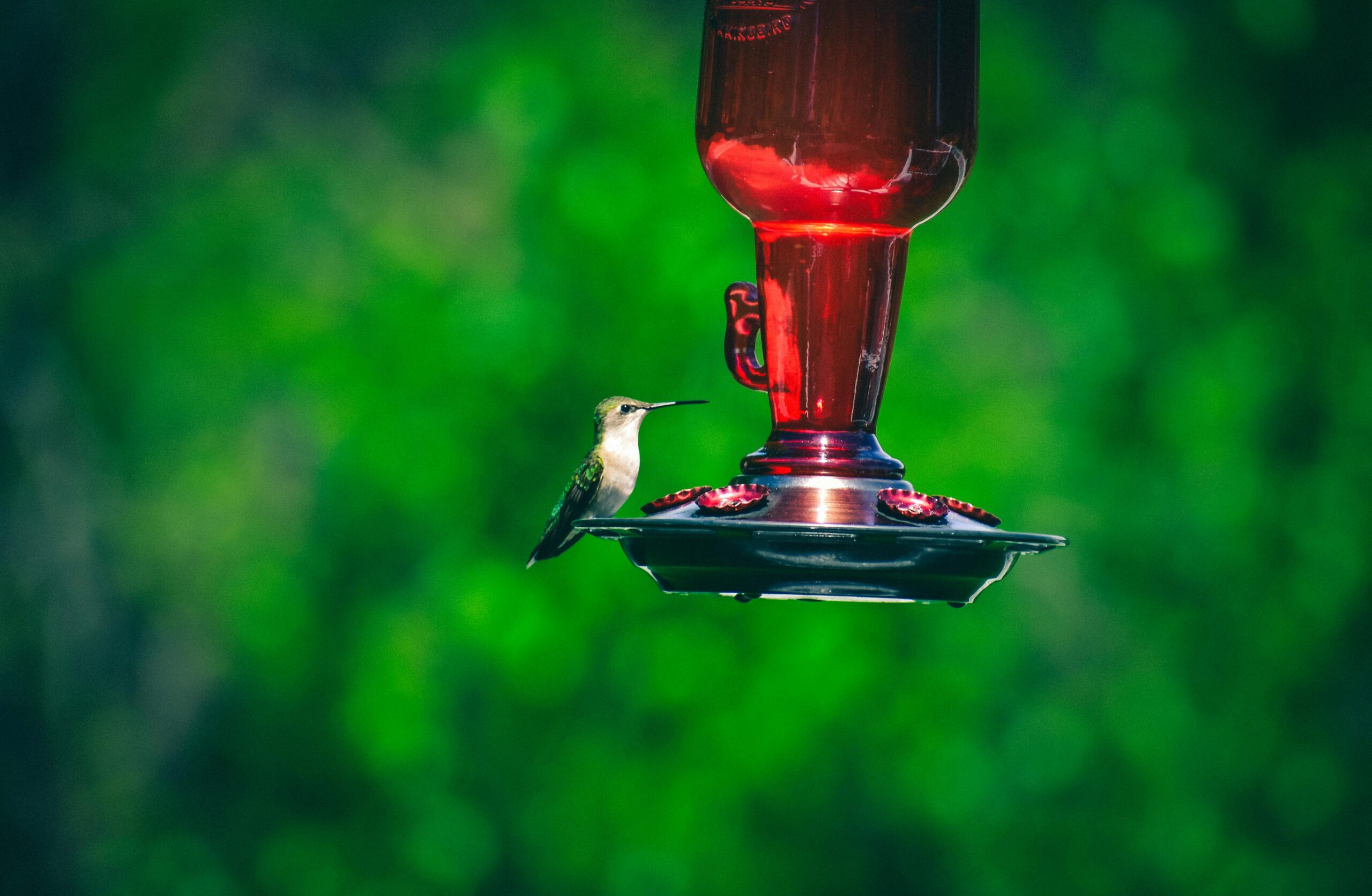
Hummingbirds are some of the world’s smallest, beautiful and most fascinating birds with a number of unique features as shown in the table below.
| Size | Hummingbirds weigh between 2-20 grams. They are the world’s tiniest bird species, exemplifying how dynamic nature can be, even in the most miniature packages. |
| Color | Hummingbirds are the most vibrant birds, having an iridescent plumage that can display a range of colors, including greens, blues, reds, and purples. |
| Flight | Hummingbirds are the most intricate avian species with extraordinary agility, renowned for their unique flight abilities, including the ability to hover, the only birds to fly backwards, and fly upside down. |
| Diet | Hummingbirds are primarily nectar feeders, but they will also catch insects or lick sap. They have a high metabolism to support their rapid flapping of their wings, which range from about 12 to 80 times per second depending on the species. They can consume up to 12 times their body weight in nectar every day. |
| Nesting | Hummingbirds build cup-shaped nests in trees or shrubs. The nests are made from spider silk and lichen, and the mother bird feeds her young with nectar and small arthropods. |
| Lifespan | The average lifespan of a hummingbird is 3–5 years, but some can live up to 10 years. |
| Pollinators | Their high nectar consumption makes them vital pollinators, as they transfer pollen from one flower to another. This makes them an essential part of the ecosystem, supporting the reproduction of many types of flowers. |
| Predators | Hummingbirds face many predators in the wild, including hawks, falcons, owls, jays, crows, and roadrunners. |
| Spiritual | Hummingbirds also symbolize deep spiritual significance, embodying love, joy, beauty, positivity, creativity and healing. Their agility and ability to hover remind us to stay present and navigate life’s challenges gracefully. |

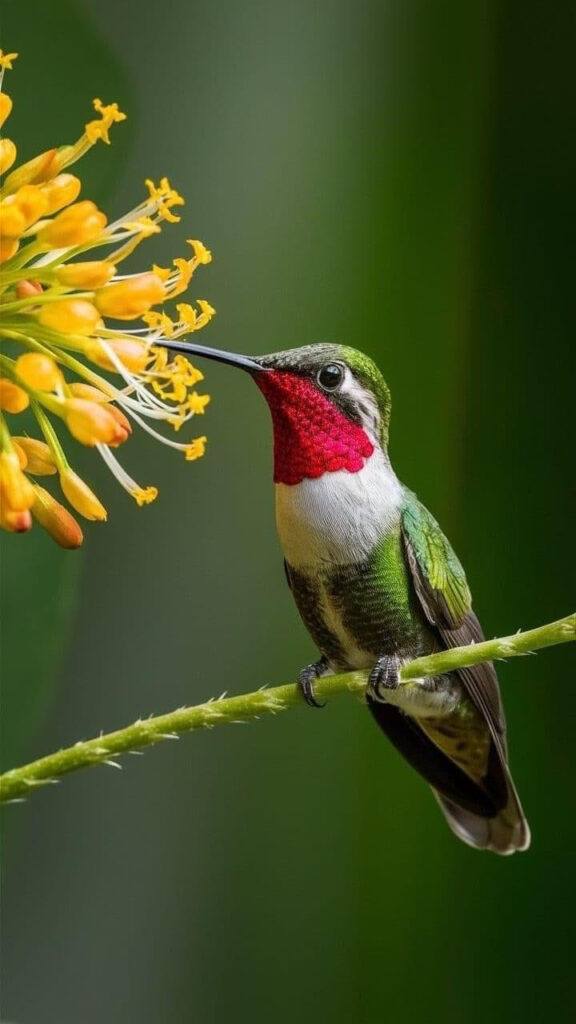
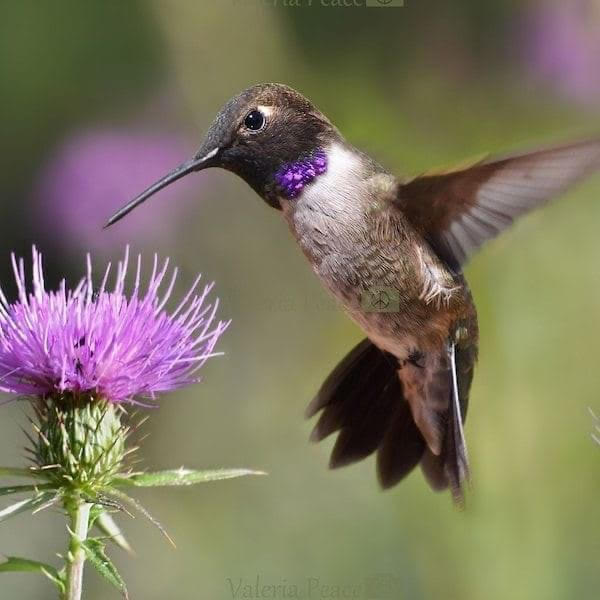
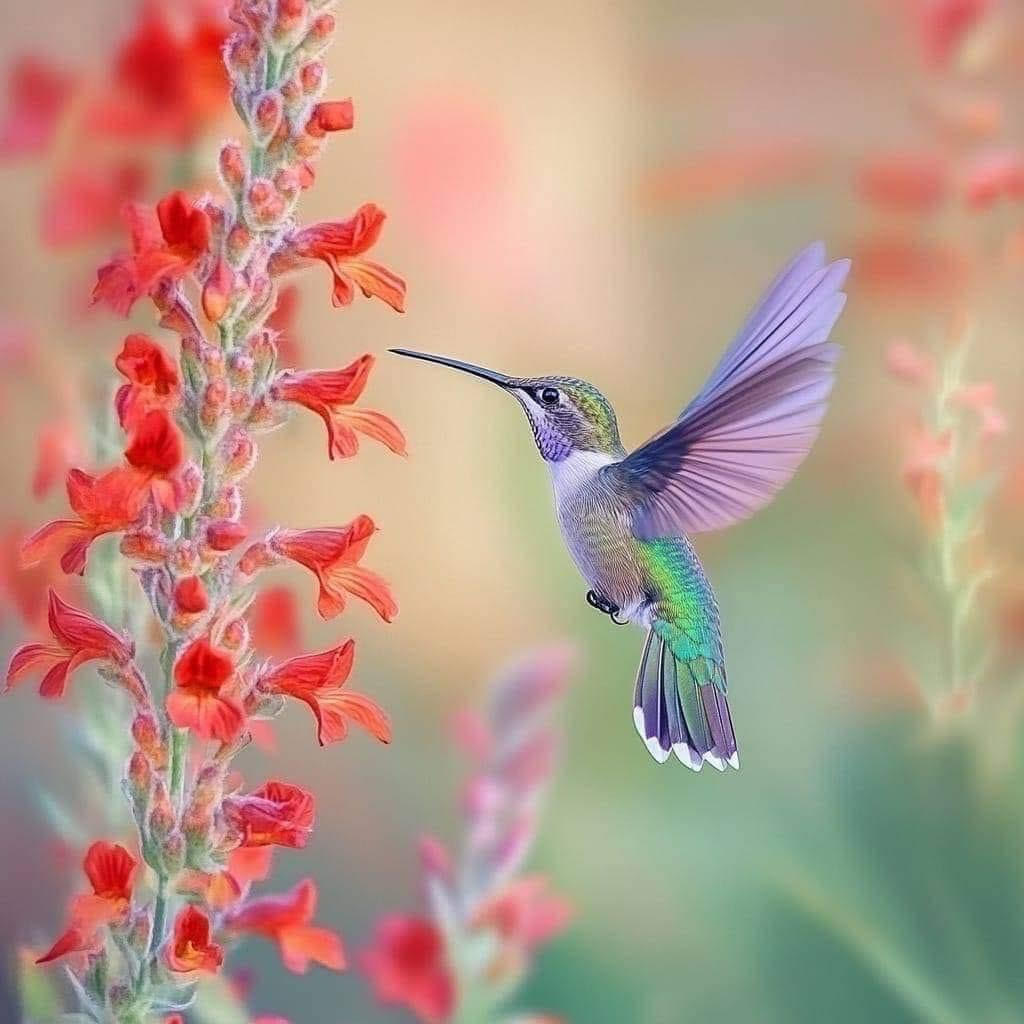

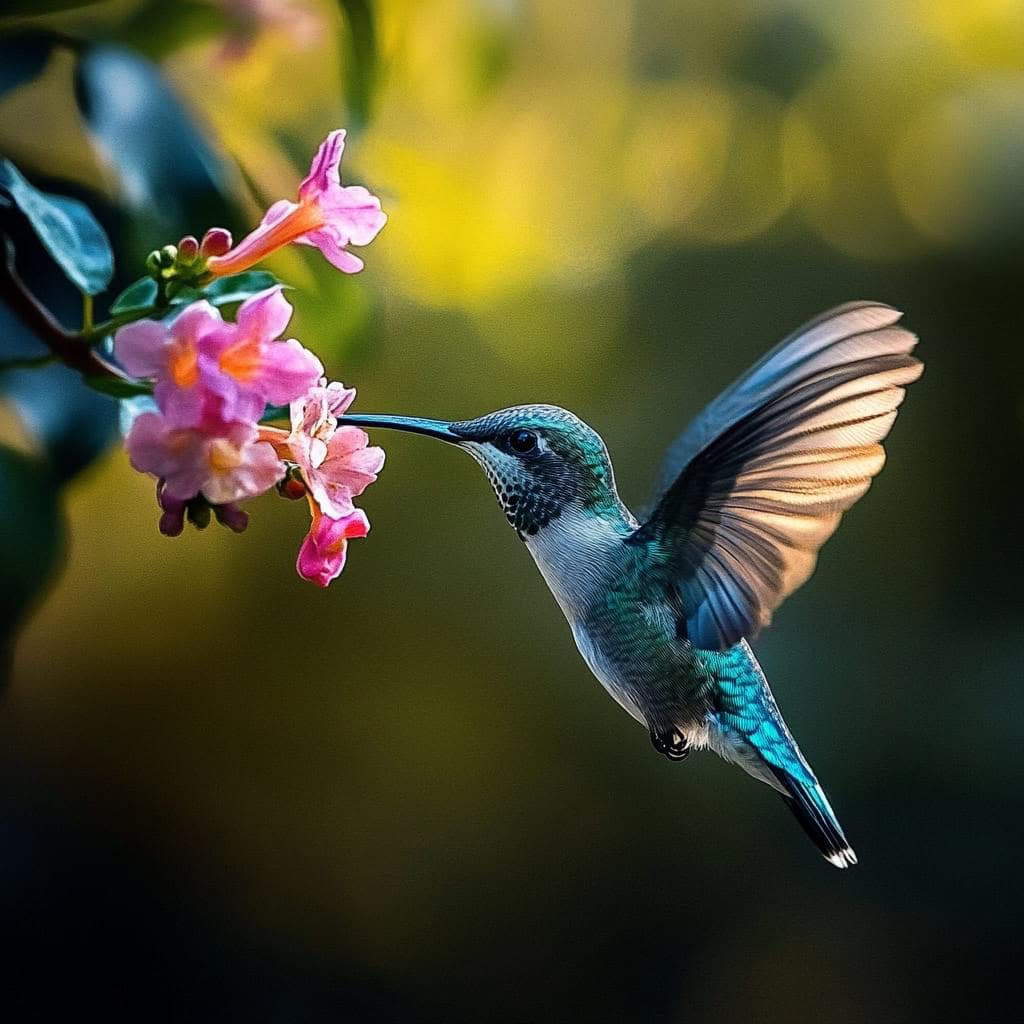
what is a hummingbird feeder?
A hummingbird feeder is a device designed specifically for feeding hummingbirds. These specialty bird feeders typically dispense a sugar-water nectar solution, which mimics the natural nectar that hummingbirds get from flowers.
Here are some key aspects of hummingbird feeders:
DESIGN
(1) Reservoir: The main part of the feeder is a container or reservoir that holds the nectar. This can be made from various materials such as glass, plastic, metal or ceramic.
(2) Feeding Ports: Small holes or tubes where the hummingbirds can access the nectar. These are often surrounded by faux flowers or other designs to attract the birds.
(3) Perches: Some feeders include small perches near the feeding ports, allowing the hummingbirds to rest as they feed.
COMMON FEATURES
(1) Red Color: Many hummingbird feeders incorporate red elements into their design, as hummingbirds are particularly attracted to the color red.
(2) Ant Moats: A common feature that involves a water-filled barrier designed to prevent ants from reaching the nectar.
(3) Bee Guards: These prevent bees and wasps from accessing the nectar while allowing hummingbirds to feed through specially designed ports.
USAGE
Hummingbird feeders are filled with a homemade or store-bought nectar solution, usually a mixture of sugar and water in a ratio that mimics the sugar concentration found in natural flower nectar. It’s important to clean and refill the feeders regularly to prevent mold and bacterial growth, which can be harmful to hummingbirds.
PURPOSE
The main purpose of a hummingbird feeder is to provide a reliable food source for hummingbirds, especially in areas or seasons where floral nectar is scarce. These feeders can help support hummingbird populations and provide a great way for people to observe these fascinating birds up close in their gardens or yards
Hummingbird feeders are popular among birdwatching enthusiasts and those who enjoy attracting and supporting wildlife in their gardens. They offer a wonderful opportunity to watch the dynamic and vibrant behaviors of hummingbirds, which are known for their incredible flying abilities and tiny size.
What is a Decorative Hummingbird Feeder?
Decorative hummingbird feeders are designed for dual purpose: to attract and feed hummingbirds (functionality), as well as to serve as decorative ornamental pieces bringing aesthetic appeal and beauty to your garden or outdoor space.
Unlike standard feeders, which may be purely functional, decorative hummingbird feeders focus on aesthetics, featuring unique shapes, vibrant colors, and intricate designs that can range from vintage styles to modern artistic interpretations. These feeders often incorporate materials like hand-blown glass, hand-painted ceramics, or sculpted metals, which can add a touch of elegance and personal style to your yard or patio.
So what is a decorative hummingbird feeder? It can be considered a unique hummingbird feeder that is an upgrade from standard feeders. It is a blend of artistry and utility that can transform your outdoor spaces into enchanting havens that nurtures both hummingbirds and personal well-being through a deep, restorative connection and immersion in nature.
Why Should Novices opt for Decorative Hummingbird Feeders?
Starting out with birdwatching can be overwhelming, and that’s where decorative hummingbird feeders come into play. They’re excellent for beginners, offering a perfect mix of form and function that make them easy to use and maintain.
From a novice’s perspective, these feeders are inviting. They require simple setup and little maintenance, yet they draw more than their fair share of tiny visitors. Their eye-catching designs also make them easy to spot, ensuring curious hummingbirds have no problem locating the feed.
One of the biggest perks for newcomers is the almost immediate gratification. Decorative feeders, with their vivid colors and glossy finishes, mimic the natural flowers hummingbirds are instinctively drawn to. This means even a novice will quickly see results without extensive trial and error.
These feeders double as educational tools. As you watch the birds, you’ll learn about their feeding habits and behavior, offering both entertainment and knowledge. There’s a simple joy in identifying visiting species and noting their unique markings, something that these feeders encourage.
Beyond utility, choosing a decorative hummingbird feeder adds enjoyment to the process. They’re a means to express personal taste while engaging in a rewarding hobby, bridging the gap between beauty and birdwatching. This makes them perfect for anyone eager to get started without getting bogged down in complex birdwatching gear.
Captivating Features to Look for in Decorative Hummingbird Feeders
Choosing a decorative hummingbird feeder is about finding one with features that will serve both you and the birds well. Beyond functionality, it is the aesthetic beauty that creates the elegance and makes these hummingbird feeders unique.
Aesthetic beauty is closely tied to the emotional responses it evokes. The vibrant colours of decorative hummingbird feeders enhance their aesthetic appeal – involving the emotions of both humans and birds. Thus, colour is a key element. The tactile qualities of materials and textures also contribute to the sensory experience of beauty. The interplay of light and surface, such as the gloss of polished surface of the unique hand-blown glass hummingbird feeder resonates on an emotional level and is perceived as aesthetically beautiful.
Here’s a guide to what to look for when making that choice.
Style
There is extensive options ranging from vintage to modern and whimsical designs. Consider what complements your garden’s existing decor, whether it’s a vibrant, colorful scheme or something more understated and elegant.
Durability
Durability is a key feature, especially if you live in an area with unpredictable weather. Look for feeders made from sturdy materials like glass or metal, which can withstand the elements. Additionally, ensure that the feeder’s components are rust-resistant and easy to clean — features that significantly extend the feeder’s lifespan.
Functional Creativity
Some feeders come with added flair, like integrated LED lights or sound features that enhance the visual and auditory appeal of your outdoor space. These little extras can make a big difference in the overall experience for both you and the birds.
Practicality
Check for features that simplify refilling and cleaning. Wide openings and detachable parts can make these tasks straightforward, saving time and reducing the chances of spills — a definite advantage for those new to bird feeding.
Here are 10 features of hummingbird feeders that not only help attract hummingbirds but also make the feeders an attractive addition to any garden or patio.
| 1. Material and Design | These feeders often come in materials like glass, ceramic, or copper, often adorned with artistic designs or patterns. The material can influence the feeder’s durability and aesthetic appeal. |
| 2. Colour | Red is a popular color for hummingbird feeders since hummingbirds are naturally attracted to red flowers. Many decorative feeders use this color in their designs, although other vibrant colors can also be effective. |
| 3. Feeding Ports | The number of feeding ports can vary, with some decorative feeders having multiple ports to accommodate several birds at once. These ports are often surrounded by faux flowers or other designs to mimic natural feeding sources. |
| 4. Ant Moats | An essential feature for many feeders, ant moats help prevent ants from reaching the nectar. These are often integrated into the design in a way that complements the overall aesthetic. |
| 5. Bee Guards | To prevent bees from accessing the nectar while still allowing hummingbirds to feed, some decorative feeders include bee guards at the feeding ports. |
| 6. Leak-proof Design | A good feeder should be designed to prevent nectar from leaking, which can attract pests and lead to wastage. Decorative feeders often incorporate special seals or construction techniques to address this. |
| 7. Ease of Cleaning | Despite their intricate designs, these feeders should be easy to disassemble and clean, as regular cleaning is crucial to prevent the spread of disease among hummingbirds. |
| 8. Perches | Some decorative feeders include perches around the feeding ports, allowing hummingbirds to rest while they feed. This feature can make the feeder more attractive to birds and easier for observers to view them. |
| 9. Hanging Mechanisms | These feeders usually come with chains or hooks for hanging, which can be ornately designed to match the feeder’s style. |
| 10. Illumination | Some high-end decorative feeders include solar-powered LED lights that gently illuminate the feeder at dusk, creating an enchanting nighttime visual and attracting hummingbirds that may feed at twilight. |
The Value of Decorative Hummingbird Feeders
A decorative hummingbird feeder enriches your garden in ways that go beyond their immediate function. They’re not just about feeding the feathered; they’re about feeding the soul with vibrancy and life.
Just imagine your garden transformed by the lively dances of these delicate birds. It brings an entirely new level of energy and charm to your outdoor spaces. These feeders invite color and movement, turning a simple green spot into a living canvas of nature’s grace.
Engaging with hummingbirds is not only visually rewarding but also psychologically uplifting. Watching their swift movements and listening to the soft whirring of their wings can be a meditative experience, reducing stress and creating moments of peace amidst the rush of daily life.
There’s an educational angle, too. Observing hummingbirds up close offers valuable insights into their behavior and characteristics, making these feeders a learning tool for curious minds — young and old alike. They spark interest in nature and encourage further exploration.
Also, there’s a social aspect to consider. Sharing the joy of these beautiful visitors with friends and family fosters connections. Whether it’s through organized events or casual gatherings, these feeders become a focal point, drawing people together to share in the delight of birdwatching.
Here are some key reasons to choose a decorative hummingbird feeder:
| 1. Visual Appeal | Decorative feeders come in various beautiful designs, colors, and shapes, turning a simple feeding function into a piece of art. This enhances the beauty of your garden or patio space, making it visually appealing not just to hummingbirds but also to human visitors. |
| 2. Attract More Bees | Hummingbirds are attracted to bright colors and unique designs that mimic the flowers they love. A well-chosen decorative feeder can attract more hummingbirds to your garden, providing you with more opportunities to watch these fascinating creatures. |
| 3. Complement Garden Themes | Whether your garden has a rustic country vibe, a sleek modern look, or a whimsical fairy garden design, there’s a decorative feeder to match every style. This helps create a cohesive look and feel in your outdoor living space. |
| 4. Perfect for Gifts | Decorative hummingbird feeders make excellent gifts for gardeners, bird enthusiasts, or anyone who enjoys outdoor decor. They are both practical and pretty, which makes them a thoughtful and appreciated gift. |
| 5. Interactive Experience | Engaging with nature has therapeutic effects, and having a decorative feeder adds an element of interaction with wildlife. It provides a reason to spend more time outdoors, observing the hummingbirds as they feed, which can be relaxing and enjoyable. |
| 6. Durable & Functional | Many decorative feeders are made from durable materials like glass or ceramic. They not only look good but are also built to last, providing a safe and reliable food source for hummingbirds. |
Choosing a decorative hummingbird feeder is an excellent way to blend functionality with aesthetic beauty, making your garden a vibrant and attractive spot for both humans and hummingbirds.
Smart Investing Tips for the Best Decorative Hummingbird Feeder
Investing in a decorative hummingbird feeder is a decision that blends aesthetics with function. To make sure you’re getting the most out of your investment, here are some tips to guide your choice.
Feeder Placement
Start by considering where you’ll place the feeder. The location impacts not just the feeder’s visual appeal but its effectiveness in attracting birds. Ideally, it should hang in a quiet, shaded area visible from a window, ensuring you enjoy the sight without disturbing the birds.
Style
When it comes to choosing a style, match the feeder to your garden’s existing decor. This creates a harmonious environment that enhances your space’s overall look. Remember, the feeder isn’t just for the birds; it’s a part of your garden’s aesthetic.
Durability
Be mindful of the materials. Opt for feeders crafted from durable materials like glass or metal, which endure various weather conditions, ensuring longevity. Look for ones with easy-to-clean parts to maintain a hygienic feeding environment for the hummingbirds.
Easy Fill
Avoid common pitfalls like overly complex mechanisms that complicate cleaning or refilling. Simplicity often means fewer parts to break or lose, making maintenance easier over time.
Value for Money
Finally, think about your budget. While decorative feeders can range widely in price, focus on finding one that balances quality with affordability. A well-made feeder is not only an investment for your garden but also for your peace of mind, knowing it will last through seasons.
What are some Types of Decorative Hummingbird Feeders?
Decorative hummingbird feeders often emphasize several key themes to attract both the birds and the aesthetic appreciation of bird watchers. Before we delve into the types of decorative hummingbird feeders, let us explore some common themes:
- Nature-Inspired Designs: Many feeders are designed to mimic natural elements like flowers, leaves, or even fruits, which not only attract hummingbirds but also blend seamlessly into a garden setting.
- Vibrant Colors: Hummingbirds are attracted to bright colors, especially red. Feeders often feature bold, striking colors that are visually appealing and effective in drawing hummingbirds.
- Artistic Elements: Some feeders are crafted with artistic touches, such as hand-blown glass, mosaic tiles, or intricate metalwork, making them not just functional but also decorative pieces.
- Eco-Friendly Materials: With a growing awareness of environmental impact, many feeders are made from recycled materials or non-toxic, sustainable resources, appealing to eco-conscious consumers.
- Innovative Features: Beyond aesthetics, decorative feeders may include innovative features like ant moats, bee guards, or drip-free designs to enhance usability and maintenance.
- Thematic Variations: Themes like vintage, rustic, or modern can dictate the style of feeders, catering to diverse personal tastes and garden decors.
These themes not only make the feeders attractive to hummingbirds but also turn them into focal points in garden décor, enhancing the overall outdoor experience.
Conclusion
We have a profound passion for hummingbirds and are dedicated to sharing that enthusiasm. Our mission is to help budding hummingbird lovers enhance their lives by transforming their outdoor areas into enchanting hummingbird havens with our carefully curated selection of decorative hummingbird feeders available online.
In this first post of our website, we delved into the question of what is a decorative hummingbird feeder. To put things into context, we briefly explored what is a hummingbird, what is a hummingbird feeder and what are the unique features of the different types of decorative hummingbird feeders. We explored the values and benefits of having a backyard garden that creates an enchanting for hummingbirds and how connecting with nature improves mental and emotional health and well-being.
We hope you found some useful information here. Lease leave us a message below or contact us if you need any clarification or free expert advice on how to start your own hummingbird haven.

